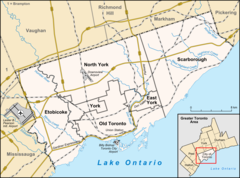Highland Creek (Toronto)
| Highland Creek | |
|---|---|
 Highland Creek and its associated valley | |
| Location | |
| Country | Canada |
| Province | Ontario |
| Municipality | Toronto |
| Physical characteristics | |
| Source | Hydro One right of way, near Brimley Road & McNicoll Avenue |
| • coordinates | 43°48′54″N 79°16′51″W / 43.81500°N 79.28083°W |
| • elevation | 186 m (610 ft) |
| Mouth | Lake Ontario |
• coordinates | 43°46′0″N 79°08′41″W / 43.76667°N 79.14472°W |
• elevation | 75 m (246 ft) |
| Length | 29.1 km (18.1 mi) |
| Basin features | |
| Tributaries | |
| • right | West Highland Creek |
Highland Creek is a
Naming
According to a 1796 list of Mississauga names of rivers and creeks compiled by British surveyor
Hydrology
Highland Creek consists of four branches, treated here in order from west to east. The names used for the branches indicate only geographic position, and should not be taken as proper names.
The north-west branch begins at the exit of a culvert at
The west branch begins at the exit of a culvert just southeast of Brimley Road and McNicoll Road at 43°48′54″N 79°16′51″W / 43.81500°N 79.28083°W. This is the most northerly point of any part of the Highland Creek system including all tributaries. It flows south-east under Finch Avenue East, McCowan Road and Middlefield Road. The branch travels 250 m (820 ft) southwest, then south to its confluence with the north-west branch. It continues southeast under

The central branch begins at the exit of a culvert north-west of Middlefield Road and Finch Avenue East at 43°48′49″N 79°15′40″W / 43.81361°N 79.26111°W. The branch flows south east, then east under Middlefield to 43°48′49.5″N 79°14′55.5″W / 43.813750°N 79.248750°W where a short 900 m (2,953 ft) tributary branch running south joins it. It then flows south-east under the Canadian Pacific Railway tracks, Finch Avenue and Markham Road, then south-east under Highway 401. From this point on, it flows in a natural bed and ravine. It then travels 500 m (1,640 ft) to the confluence with the west branch. The branch then travels south-east under
The east branch rises immediately south of Highway 401, west of
Highland Creek Wetland Complex
At the mouth of the Creek are four wetlands totaling 7.6 hectares (19 acres) in size. The Stephenson’s Swamp is both a designated Environmental Significant Area and a Provincially Significant Wetland. According to the Toronto and Region Conservation Authority, the type of forest swamp used to be the most common type of wetland on Lake Ontario prior to European settlement but are now rare. It is a breeding area for several uncommon species, including the blue-gray gnatcatcher and the yellow-spotted salamander.[3] There are three other designated Environmental Significant Areas in the Highland Creek watershed: Highland Forest, Hague Park and the Morningside Park Forest.
Tributaries
Threats from development
Due to development in Scarborough, which has substantially increased the amount of water that historically travelled through the river, there are a number of artificial diversions (use of control channels) to decrease erosion and guide the river past obstacles. For example, there are a large number of areas where the river is lined with rock cages. There are small dams to even out the flow in areas where upstream storage reservoirs are possible, increasing its depth. The river travels through culverts under some major streets. In addition, many of the city's storm sewers drain into the river. The valley of Highland Creek contains a number of interconnected parks which have a system of paved bike and walking paths. As a result of these numerous channel modification projects, mostly implemented in the 1960s and 1970s, much of the creek does not follow its natural path. This is in contrast to the nearby Rouge River, which has fewer in-stream barriers and extensive riparian and floodplain vegetation, and where a wider variety of wildlife, including some climax forest species, can be found.
History
Like many creeks and river valleys in Toronto, evidence of First Nations occupation has been found in this area. A 2005 excavation by the Toronto and Region Conservation Authority near the mouth of Highland Creek found evidence of a Late Woodland or Early Archaic site, thought to have been a place of tool manufacture. The Helliwell family, one of the first settlers in the area, accumulated a large number of artifacts from the last 5,000 years.[1]
Highland Creek historically formed a natural barrier to transportation in the eastern part of Scarborough, with the single exception of Military Trail, blocking the eastern sections of
During the late 1940s and early 1950s, a new town plan developed in the valley between Kingston Road and the eastern crossing of Lawrence Avenue. The primary road remains as the park access road to Colonel Danforth Park, but the remainder, with few exceptions, was washed out during Hurricane Hazel in October 1954.
Communities along the creek
Highland Creek is also the name of a neighbourhood on the east side of the creek at Old Kingston Road. Opposite the former village of Highland Creek is West Hill, named for its position on the tablelands above the valley.
See also
References
- ^ a b Fairburn 2013.
- ^ "Scottish Place Names - Toronto, Ontario, Canada". Rampantscotland.com. Retrieved January 29, 2017.
- ^ "Highland Creek Connect: What Makes Stephenson's Swamp Important?". Toronto and Region Conservation Authority. Retrieved January 29, 2017.
- Fairburn, M. Jane (2013). Along the Shore: Rediscovering Toronto's Waterfront Heritage. Toronto, Ontario, Canada: ECW Press. ISBN 9781770410992.
- "Topographic Map sheet 30M14". Atlas of Canada. Natural Resources Canada. February 6, 2006. Archived from the original on August 3, 2010. Retrieved December 11, 2007.
- "Highland Creek Watershed (map)". Watershed Strategies - Highland Creek. Toronto and Region Conservation Authority. Archived from the original on October 14, 2007. Retrieved June 12, 2008.

